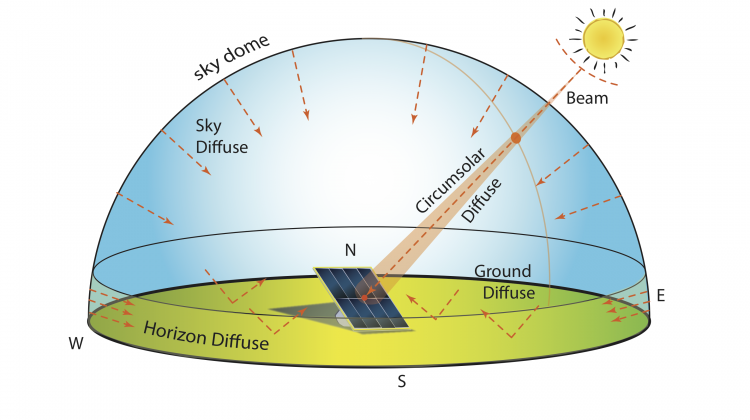Overview
This is the last big push to bring everyone in the class up to speed on solar resource topics, so stick with it, folks! We will be learning a lot more about measuring light directly in the field relative to estimated light calculations based on empirical (data-driven) correlations.
Why do our eyes create so much bias in determining solar decision making? Is there something better than vision to compare the solar resource? Is the human eye really designed to be a solar detector of intensity? It's time to come eye to eye with our embedded ethics of measurement in society. More on that soon!
We use the concept of components to break the sky dome and the ground into digestible chunks of surfaces with common emission/absorption/ scattering characteristics (e.g., direct, Gb, diffuse, Gd, circumsolar diffuse, ground reflected diffuse, Gg). Components of global irradiance relate to the sources of light within the sky dome. A component is a term for the groups of physical orientations and scattering of light (e.g., diffuse component, beam component). The characteristic measures are assessed within temporal blocks as statistical summations of irradiation on a horizontal surface (e.g. G / I / H / H-bar / annual) and the degree of light scattering found on a horizontal surface via the clearness indices (e.g., kT, KT, K-barT ).

We shall see that when it is challenging or costly to measure multiple components of light (scattered and unscattered), we have old and somewhat dated tools to attempt broad estimations on the contributions of each component to the total irradiation incident on the aperture of interest. You will see how we often rely on historical observations and empirical correlations by solar scientists and engineers for hourly, daily, and monthly average day data. The main tools used for these older equations are both measured hourly Global Horizontal Irradiation (GHI, or I) gathered from a horizontally mounted pyranometer, and daily extraterrestrial irradiance (Air Mass Zero = AM0, or Top Of Atmosphere = TOA, or just I0), which you learned about in the last chapter. We shall also find that one can infer more than just the components of light from the ratios of measured irradiation to AM0 calculated irradiation--however, there can be significant errors included in the process. We can also describe the fractions of days in a given month where lighting conditions will be clear or overcast/cloudy.
You will also see reference to the Typical Meteorological Year. Keep an eye out for that...it will be a major part of SAM simulation software.
Math warning!
You will observe several equations that are long and complicated. They are empirical relations that will be used to estimate the solar resource on non-horizontal surfaces. As with prior lessons, these equations are at the core of software like SAM, and a student completing this course should be very familiar with their application. Stick with it!
